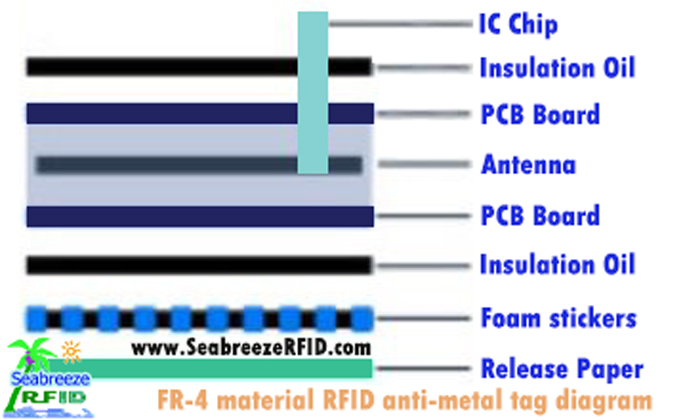Le efecto antiinterferente ti' le etiqueta electrónica RFID anti-metal
13/10/2023
Le efecto antiinterferente ti' le etiqueta electrónica RFID anti-metal
RFID anti-metal electronic tag, Xan k'ajo'olta'an bey etiqueta antimetal u ka'anal frecuencia (de acuerdo con le requisitos úuchik yéetel le entorno yo'osal, Bey xan u páajtal personalizar utia'al u etiquetas antimetal u baja frecuencia 125 KHz leti' 134,2 KHz wa etiquetas antimetal u frecuencia ultra u ka'anal u 860 ~ 960 MHz, yéetel xan u páajtal personalizar utia'al u etiqueta antimetal activa u 2,45 GHz), is an electronic tag made of absorbing material with anti-interference function, which effectively solves the problem of RF signal interference of the metal carrier on the electronic tag attached to its surface.
The outer layer of RFID anti-metal electronic tag is composed of FR-4 material, which is equivalent to adding a special anti-metal absorbing material on the basis of the original tag, to prevent the interference of metal objects on the tag signal, the tag also has anti-corrosion, impermeable, acid-proof three-proof function, high temperature resistance, impact resistance, Anticolisión, suitable for a variety of harsh use environments.
RFID anti-metal electronic tag as absorbing material in the role of signal interference
RFID anti-metal electronic tags with absorbing materials have the following characteristics:

1. RFID anti-metal electronic tags can read their standard data by customization to improve the efficiency of the application system;
2. RFID anti-metal electronic tag reading distance is far (its reading and writing distance is related to RFID reader and antenna);
3. Super anti-interference ability;
4. Long data retention time, tak 20 Ja'abo'ob, cost-effective;
5. Multi-tag reading, not affected and limited by the number of tags in the workspace;
6. RFID anti-metal tag adopts ultra-wide working frequency band design, which not only meets relevant industry regulations, but also can be flexibly developed and applied;
7. The storage area is used by users to encrypt read, write, erase and write operations, and can also specify a permanent dedicated word area for users.
With the development of the Internet of Things, the application of wave absorbing materials in RFID tags has been very common, and RFID anti-metal electronic tags are also used in various environments, including logistics management, warehousing management, asset management and other places. So what is the role of absorbing materials in RFID anti-metal tags?

In the RFID frequency range, when the electromagnetic wave encounters the metal surface, due to the eddy current phenomenon, a strong electromagnetic wave reflection is generated, and there is a phase difference between the reflected electromagnetic wave and the incident wave, resulting in mutual cancellation, at this time the truly effective electromagnetic field is rapidly reduced, because the lower the resistivity of the metal material, the greater the eddy current loss will be caused, the more serious the metal problem. Tune', when the wire is subjected to extreme metal interference, the instructions issued by the card reader will completely disappear, so the data reading result is failed. The wave absorbing material mainly uses the characteristics of high permeability. When used, the wave absorbing plate is inserted between the corrugated antenna of the RFID anti-metal tag and the metal substrate to increase the probability of the induced magnetic field passing through the metal plate through the wave absorbing material itself, thereby reducing the generation of induced eddy current in the metal plate. The wave absorbing material then reduces the loss of the induced magnetic field. Because of the insertion of the absorbing material separator, the measured parasitic capacitance will also be reduced, and the frequency offset will be reduced, which is consistent with the resonance frequency of the card reader, thus greatly improving the card reading effect and distance.
Some projects in life will encounter a variety of environments, such as high and low temperatures, liquids, cement walls, strong magnetic, metal and so on.
Je'ebix., in the metal environment, in the ultra-high frequency (UHF) radio frequency identification tag system, the identification of the tag attached to the metal carrier is particularly difficult, because the metal obstacles will reflect and interfere with electromagnetic waves. Bejla'e', there are mainly four ways to effectively solve the problem of grasping information on the metal surface:
1. The use of absorbing materials to absorb excess electromagnetic waves;
2. Padded height design;
3. The bandwidth of the tag antenna should be sufficient;
4. Grounding type antenna design.
Bejla'e', our common way is to adopt the combination of absorbing materials and padded height, and the ideal way is to design an antenna with a large bandwidth, and then use absorbing materials to padded the height, which will achieve the best effect.
(Fuente: Shenzhen Seabreeze Tarjeta na'at Co., Ltd.)
Ma' xaan ka' utsak xan
Aidc, Billete electrónico, Pegatinas, Etiqueta RFID, Pulsera NFC, Llavero, Asistencia k'iin, Kaambalil yo'osal u muuk'
Ju'unil©2013 | Shenzhen Seabreeze SmartCard Co., Ltd. | Sitemap



























































































 Fung
Fung
 Gerente u Ventas
Gerente u Ventas